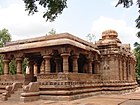Pattadakal
|
Pattadakal ಪಟ್ಟದಕಲ್ಲು Paṭṭadakallu |
|
|---|---|
| town | |

Group of monuments at Pattadakal
|
|
| Coordinates: 15°56′54″N 75°48′57″E / 15.9484°N 75.8159°ECoordinates: 15°56′54″N 75°48′57″E / 15.9484°N 75.8159°E | |
| Country | India |
| State | Karnataka |
| District | Bagalakote |
| Languages | |
| • Official | Kannada |
| Time zone | IST (UTC+5:30) |
| Nearest city | Badami |
| Group of Monuments at Pattadakal | |||||||||
|---|---|---|---|---|---|---|---|---|---|
| Name as inscribed on the World Heritage List | |||||||||
|
|||||||||
Pattadakal, also spelled Paṭṭadakallu, is an UNESCO inscribed World Heritage site. It is a village and an important tourist centre in the state of Karnataka and is located on the left bank of the Malaprabha River in Bagalakote. It is 22 kms from Badami, and about 10 kms from Aihole, both of which are well known for Chalukya monuments. It is 514 kms from Bengaluru. The Pre-Chalukya historical and archaeological site Bachinagudda is also near Pattadakal.
Pattadakal is the historical location where Badami Chalukya kings were crowned as it was considered a holy place. Vijayaditya was the first ruler to be crowned here at "Pattadakisuvolal" at the start of 7th century AD. It was the capital of the Chalukya dynasty of Karnataka in Southern India between the 6th and 8th centuries. The Chalukyas built many temples here between the 7th and 8th centuries. There are ten temples at Pattadakal, including a Jain sanctuary surrounded by numerous small shrines and plinths in fusion of various Indian architectural styles of north India and south India (Rekha, Nagara, Prasada and Dravida Vimana). These temples reflect the various religious sects that existed here. Four temples were built in the Chalukya Dravida style, four in the Nagara style of Northern India, while the Papanatha temple is a fusion of the two idioms. In all, nine Shiva temples and a Jaina basadi (called Jain Narayana temple built in the 9th century during the reign of Krishna II of Rashtrakutas, the last temple to be built at Pattadakal), are situated along the northern course of a river. The oldest of these temples is Sangameshwara built during the reign of Vijayaditya Satyashraya during the period 697-733 AD. The largest of all these temples in Pattadakal is the Virupaksha Temple was built by Queen Lokamahadevi and Rani Trilokyamahadevi, between 740 and 745 AD to mark their husband Vikramaditya II's victory over Nandivarman, the Pallava king of Kanchipuram from South; the temple was patterned on the lines of the Kailasanatha temple at Kanchipuram. They also built the Mallikarjuna temple.
...
Wikipedia









